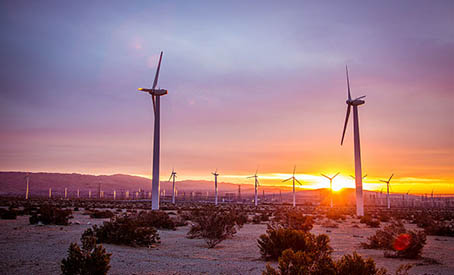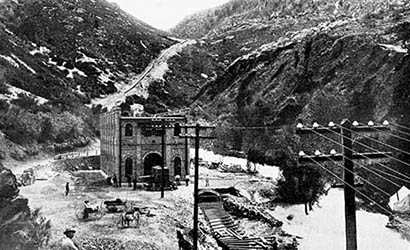Learn

Hydroelectric Energy
Hydroelectric energy is energy that is generated through moving water.
Hydro-power is one of the oldest sources of energy. It was used thousands of years ago to turn paddle wheels to help grind grain.
The first industrial use of hydro-power happened in 1880 when 16 lamps in the Wolverine Chair Factory in Grand Rapids, Michigan were powered using a water turbine. The 1st hydroelectric power plant opened in 1882 on the Fox River near Appleton, Wisconsin.

Completed in 1936, 600 feet high Hoover Dam supplies electricity for parts of California, Nevada, and Arizona. It is also capable of irrigating 2 million acres.

How It Works
Hydroelectric energy is harnessed by damming rivers to form large reservoirs or lakes. The reservoirs or lakes created from damming rivers are often called backwater. This water in the reservoir behind the dam is a form of potential energy. It has energy based on its position above the dam and river below.
When the water is released through the dam, the potential energy is converted over into kinetic energy — energy of motion.
This energy in the moving water is then able to be converted to electrical energy within the hydroelectric power plant within the dam itself. The faster the water moves, the more energy there is available.

As the water moves through the dam system, its movement turns large turbines that turn a generator which converts the kinetic energy of the water into electrical energy.
The turbine and generator system is much like those in a coal burning power plant.
Visit USGS Hydroelectric power: How it works to see how a hydroelectric power plant generates electric current and what the turbine and generator look like.
The Tennessee Valley Authority (TVA) is responsible for managing hydroelectric power plants that occur along the Tennessee River. Several of these plants are located in northern Alabama.
Alabama Power: Generating Plants shows all of the power plants in Alabama that are maintained by Alabama Power: hydro, coal, nuclear, and gas. Click on the hydroelectric plant nearest where you live to read more about the plant.

Advantages and Disadvantages of Hydroelectric Power Plants
Pros
Unlike fossil fuel burning power plants, hydroelectric plants do not emit harmful greenhouse gases into the atmosphere.
Cons
While hydroelectric power plants are not harmful to the atmosphere, they still have negative environmental impacts.
- Like nuclear energy, they can be indirectly responsible for greenhouse gases being added to the atmosphere. Most often, machinery that use burn fossil fuels to work are used to clear the land for the dam, build the dam, and make the materials that are used in the dam's construction.
- Also hydroelectric power plants depend on water stored in reservoirs that have been created by damming rivers. Now these areas of land that were once available as habitat for terrestrial organisms have been destroyed through flooding.
- Dams can also disrupt fish migration up/down stream, change water temperature and chemistry, and change silt loads. These changes in the river can change the ecology and physical characteristics of the river affecting native plant and animal life.
- Hydroelectric power plants depend on the water cycle. Their energy output can be affected by droughts. When drought conditions occur, the amount of surface water is reduced, reducing the amount of available potential energy that can be used for the generation of electricity.

Wind Energy
Wind energy is a source of renewable energy that is extracted from flowing air. Wind energy is a form of solar energy. Wind is caused by
- uneven heating of the atmosphere by the sun,
- irregularities of the earth's surface, and
- the rotation of the earth.
Wind flow patterns are influenced by the earth's terrain, bodies of water, and vegetative cover.

White Water / Palm Springs, Riverside County, California. View larger version. Image courtesy of Tony Webster.
This file is licensed under the Creative Commons Attribution 3.0 Unported license.
This kinetic energy is harnessed by mechanical devices known as wind turbines or windmills.
These structures extend into the sky where their large blades are turned by the wind in the atmosphere. As the wind moves these large blades, a generator within the structure is turned converting the wind energy into electricity.
These wind turbines can be thought of as being the opposite of a fan. A fan uses electricity to turn blades to produce wind. A wind turbine uses wind energy to turn large blades to generate electricity. Visit U.S. Department of Energy: Utility-Scale Land-Based 80-Meter Wind Maps to see a map of to see the potential for wind energy use. You can click on each state to read more about wind availability.

Map of wind potential. Note that wind potential varies greatly across the country, with stronger potential near the West Coast and Great Plains and poor potential in the Southeast.

Advantages and Disadvantages of Wind Energy
Pros
Like most alternative sources of energy, wind energy is a renewable energy source that does not emit hazardous greenhouse gases and pollutants into the atmosphere.
Cons
Although wind energy has less impact on the atmosphere, it still has some negative environmental impacts.
-
Wind turbines take up land area that might otherwise be used for something else.
-
The blades on the wind turbines can be hazardous to birds and bats. These animals can be killed by flying into the moving blades.
-
Wind turbines also produce noise that can be unpleasant.
-
The wind turbines themselves are not very aesthetically pleasing—they are "eye sores".
-
Harnessing and using wind energy is expensive, especially the initial set up, when compared to using fossil fuel technology.
-
Like solar energy, wind energy is an intermittent source of energy, meaning that it is not always available when needed.
-
Wind energy cannot be stored, and the best sites for wind energy are often in remote areas far from the areas where the electric demands are highest, such as cities. This means that electricity generated by these wind turbines has to be sent over long distances which makes it less efficient as a source of energy.
 |
 |

